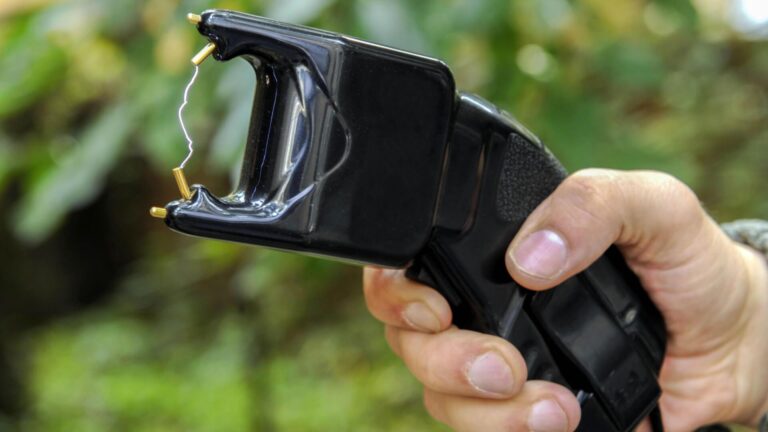Table of Contents
- Understanding Stun Gun Regulations Across Different States
- Legal Requirements for Obtaining a Stun Gun Carry Permit
- Safety Guidelines and Responsible Use of Stun Guns
- Practical Tips for Choosing the Right Stun Gun and Avoiding Legal Issues
- Future Outlook
Understanding Stun Gun Regulations Across Different States
When it comes to carrying a stun gun, regulations can vary widely depending on the state you’re in. Some states classify stun guns as firearms or weapons, imposing strict regulations, including mandatory permits or licenses for possession and use. Other states may allow stun guns with minimal restrictions, while a handful ban them entirely. It’s important to remember that local laws often differ from state laws, so checking city or county statutes can also be crucial. Additionally, some states have age restrictions and may require background checks before purchase or carry, highlighting the need for thorough research before acquiring a stun gun.
Common requirements you might encounter include:
- Permit or License: Some states require you to obtain a permit similar to a concealed carry license before carrying a stun gun.
- Age Restrictions: Most jurisdictions set a minimum age of 18 or 21 to legally possess or carry a stun gun.
- Restricted Locations: Even with a permit, stun guns are often prohibited in schools, government buildings, and certain public places.
- Transport Rules: Regulations may dictate how stun guns must be carried in vehicles, sometimes requiring them to be unloaded and stored separately.
Legal Requirements for Obtaining a Stun Gun Carry Permit
Before carrying a stun gun, it’s crucial to familiarize yourself with the specific legal framework governing their possession and use. In many jurisdictions, obtaining a permit is not just a formality but a legal necessity. The process often involves background checks, proof of residency, and sometimes completing a safety training course. Requirements can vary widely depending on the state or country, so it’s essential to consult local laws to avoid costly fines or criminal charges.
Key factors to consider include:
- Age restrictions: Most regions require applicants to be 18 or older.
- Criminal history: Individuals with certain convictions may be disqualified from obtaining a permit.
- Permit application: Often involves submitting identification, fingerprints, and paying a fee.
- Renewal requirements: Permits may need regular renewal with ongoing compliance checks.
Safety Guidelines and Responsible Use of Stun Guns
When handling a stun gun, prioritizing safety is non-negotiable. Always familiarize yourself with the device’s operation before carrying it, ensuring that you understand how to activate and deactivate it correctly. Never aim a stun gun at the face or head of any person, as this can cause serious injury. Store your stun gun securely, out of reach of children or unauthorized individuals, and routinely check to ensure the battery is fully charged for reliable performance. Remember, malfunctions or improper use can endanger both the user and others around them.
Responsible use also means being aware of your surroundings and the legal boundaries in your area. Before pulling out or deploying a stun gun, assess whether the threat justifies its use, keeping in mind that it is primarily designed for self-defense, not aggression. Adhering to these practices helps maintain safety and prevents legal complications. Consider these essential tips for responsible carry:
- Keep the stun gun accessible but concealed to avoid unnecessary alarm or conflict.
- Never use a stun gun while under the influence of drugs or alcohol.
- Attend a safety training session or seek professional advice for hands-on practice.
- Check local and state laws regularly, as regulations can change and affect legal possession and use.
Practical Tips for Choosing the Right Stun Gun and Avoiding Legal Issues
When selecting a stun gun, it’s essential to prioritize models that balance effectiveness with safety and legal compliance. Consider features like voltage strength, size, and ease of use, but equally important is understanding local and state regulations that govern stun gun possession. Opt for products from reputable manufacturers that include clear instructions and safety features such as automatic shutoff and low battery indicators. Additionally, choose a stun gun with a comfortable grip and a discreet design that suits your lifestyle without drawing unwanted attention.
To stay compliant and avoid legal trouble, take these practical steps:
- Research your jurisdiction: Laws regarding stun guns vary widely-from permit requirements to outright bans. Check official government resources or consult a legal professional.
- Carry documentation: If permits or licenses are needed, keep them with you when carrying your stun gun to quickly demonstrate compliance.
- Use with caution: Remember that stun guns are self-defense tools-not weapons for aggression. Misuse can lead to criminal charges.
- Stay updated: Laws can change, so periodically review the legal status of stun guns in your area to ensure ongoing compliance.
Future Outlook
In today’s evolving landscape of personal security, understanding the legal requirements surrounding stun guns is essential. While regulations vary widely depending on your location, knowing whether you need a permit to carry a stun gun can help you stay compliant and protect yourself responsibly. Always take the time to research local laws, consult official resources, and consider your own safety needs before carrying any self-defense device. Staying informed ensures that you can confidently carry your stun gun within the boundaries of the law, giving you peace of mind and the protection you deserve.Check Our Other Blogs
- StunGun – Your Trusted Source for Stun Guns, Laws, and Self-Defense Tips
- PepperSprayLaws – Your Trusted Resource for Pepper Spray Information
- StunGunLaws – Your Trusted Guide to Stun Gun Legality and Safety



